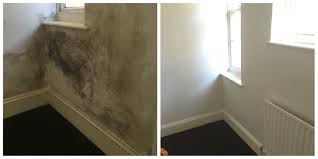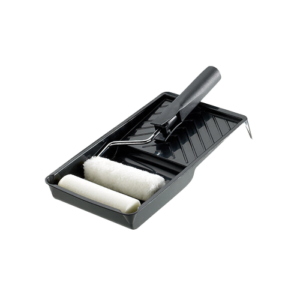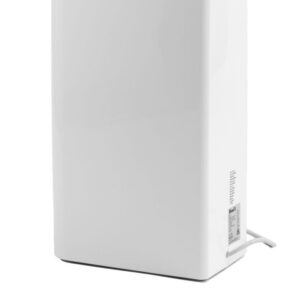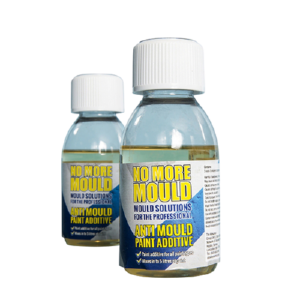Last Updated on May 13, 2025 by Ferg
Make sure to check out our best tips to find out the dangers of Black Mould and how to identify it!
Black Mould on ceiling and other areas can have adverse effects on health, cause cosmetic issues and being a general eyesore in your home or building. Whether you are a tenant or a landlord, this guide will help you treat and prevent Black Mould and Mildew in most cases. The supplies that you’ll need for this are; Fungicidal Mould Wash, Anti-Mould Paint Additive, cloths and painting supplies. Optional extras include a humidistat, dehumidifier and Insulating Paint.

Step 1: Kill the Mould/Mildew
The Mould needs to be treated with a fungicidal wash to ensure the fungus is killed and prevent the spores from becoming airborne. In some cases, bleach may not kill the mould and actually promote it to grow back quicker. Spray the affected area down with a fungicidal wash and then wash with warm soapy water. Repeat as necessary. The Damp Store’s No More Damp Mould Eradication Kit will have most of the required tools and supplies.

Step 2: Treat the area
Once the Mould is killed and the area is clean and dry, you should apply an anti mould paint or spray on the area. This will prevent the growth of mould on the surface. Above mould kit

Step 3: Prevention of the Source
The underlying cause of Black Mould and Mildew is a high level of humidity in the room. When the humidity level rises above 60% it allows condensation to form on cold surfaces and creates the ideal conditions for mould and mildew to grow.

To keep the humidity level below 60% there are several things you can do. Having a humidistat to measure the humidity is a good step to take so you can understand your situation and decide how much or how little you need to do. Running a dehumidifier like our Wood’s MDK11 Dehumidifier in the affected area will reduce the humidity and will help in the more severe cases of high humidity. In lesser cases, small changes in lifestyle can fix the problem almost instantly. The key things you need to look out for when living with these conditions are that you control the ventilation by making sure you run the extractor fan in the bathroom, preferably on a timer for 10-15 minutes after the shower, use the extractor in the kitchen when cooking, and also avoid drying clothes inside while keeping your heating level consistent throughout the building.
Browse Condensation Products
-
 Positive Input Ventilation (PIV) Unit€850.00
Positive Input Ventilation (PIV) Unit€850.00 -
 ISO-THERM and Adhesive Kit€350.00
ISO-THERM and Adhesive Kit€350.00 -
 ISO-THERM Insulation Adhesive
ISO-THERM Insulation Adhesive -
 ISO-THERM – Thin Internal Wall Insulation
ISO-THERM – Thin Internal Wall Insulation -
 Stanley 2 Sleeve Mini Roller Tray & Frame Set 100mm (4″)€7.00
Stanley 2 Sleeve Mini Roller Tray & Frame Set 100mm (4″)€7.00 -
 Stanley Masonry Roller Set 225mm (9″)€18.95
Stanley Masonry Roller Set 225mm (9″)€18.95 -
 Dehumidifier 20 Litres per Day€270.00
Dehumidifier 20 Litres per Day€270.00 -
 Thermal Dry Insulating Paint€40.00 – €70.00
Thermal Dry Insulating Paint€40.00 – €70.00 -
 Anti Mould Paint Fungicidal Additive – MCS3€15.00
Anti Mould Paint Fungicidal Additive – MCS3€15.00
Bonus Tip: If you have mouldy clothes in a wardrobe or closet, you can increase the ventilation or put some small dehumidifier packets in there to help.
Save this infographic for easier reminder on how to treat and prevent black mould

If the problem persists after implementing the above, get in touch with a specialist at The Damp Store for further advice.
Frequently Asked Questions
Is it possible to get rid of mould on walls permanently?
Mould growth is typically caused by ongoing dampness, poor ventilation, or leaks. Effective mould treatment involves addressing the underlying moisture issues first. Professional black mould removal services, such as those offered by The Damp Store, ensure thorough cleaning and the application of preventative treatments that inhibit future mould growth. Additionally, improving ventilation, regularly using a dehumidifier, and promptly repairing leaks are critical. Implementing these measures drastically reduces the likelihood of mould returning. Consistent home maintenance and vigilance, including regular inspections, significantly help maintain a mould-free environment in the long term.
What sets The Damp Store apart from other damp contractors in Ireland?
The Damp Store stands out among other damp contractors in Ireland through its comprehensive and customer-focused approach. Specialising in black mould treatment, The Damp Store combines advanced techniques with eco-friendly products to safely and effectively treat mould on walls. Their team of highly trained professionals offers bespoke solutions tailored to individual needs, ensuring lasting results. Transparent pricing, detailed consultations, and commitment to customer satisfaction further distinguish their service. The Damp Store also emphasises educating homeowners on preventative measures, equipping clients with knowledge to prevent recurrence. Their dedication to quality workmanship and attentive customer care positions them uniquely within Ireland’s damp control industry.
What causes black mould to grow in homes?
Black mould thrives in homes primarily due to excess moisture and inadequate ventilation. Common causes include condensation from high humidity levels, especially during colder months, and persistent damp conditions resulting from plumbing leaks, roof leaks, or rising damp. Poor ventilation exacerbates moisture accumulation, particularly in areas such as bathrooms, kitchens, basements, and poorly insulated rooms. Surfaces like walls, ceilings, and even furniture provide the ideal organic material for mould to feed and grow on. Black mould, prevalent in Ireland’s humid climate, flourishes quickly when conditions remain unchecked. Regularly managing humidity and addressing dampness promptly can effectively mitigate mould growth and maintain a healthier home environment.
Is black mould dangerous to health?
Black mould can indeed pose significant health risks, particularly to vulnerable individuals such as children, the elderly, and those with compromised immune systems or respiratory conditions. Exposure to black mould spores can trigger allergic reactions, asthma attacks, respiratory infections, and other respiratory issues. Symptoms include coughing, wheezing, skin irritation, and fatigue. Long-term exposure may lead to more severe health concerns, including chronic respiratory illnesses. Prompt and thorough black mould treatment is crucial to safeguard health. Professional mould removal services not only eliminate visible mould but also reduce airborne spores, significantly lowering health risks. Regular cleaning and controlling home humidity levels further mitigate these dangers.
How to prevent black mould from coming back?
Preventing the recurrence of black mould involves proactively addressing moisture control and enhancing home ventilation. Regularly inspect your property for leaks, ensuring prompt repairs of plumbing issues, roof leaks, or condensation problems. Maintain indoor humidity below 50% using dehumidifiers, particularly in high-risk areas like bathrooms, kitchens, and basements. Improve ventilation through extractor fans, air vents, or occasionally opening windows. Regularly clean susceptible surfaces with anti-mould products or diluted bleach solutions to discourage mould spores from settling and proliferating. Consistent vigilance combined with immediate intervention at early signs of moisture buildup significantly reduces the likelihood of black mould returning, keeping your home healthier and safer.
Are dehumidifiers effective in controlling mould?
Yes, dehumidifiers are highly effective in controlling mould, particularly by managing indoor humidity levels and reducing moisture that promotes mould growth. Dehumidifiers extract excess moisture from the air, maintaining humidity levels ideally below 50%, making the environment inhospitable for black mould and mildew. They are especially beneficial in high-risk areas such as bathrooms, kitchens, laundry rooms, and basements where dampness frequently occurs. Regular use significantly decreases condensation on surfaces and prevents mould spores from thriving. However, while dehumidifiers effectively control moisture, they should be complemented by good ventilation practices, regular cleaning routines, and professional mould treatments for optimal and lasting mould control results.
Does black mould only grow in damp areas like bathrooms?
While bathrooms and other damp areas are common sites for black mould growth due to consistent moisture, black mould can appear anywhere conditions support its growth. Any area of a home exposed to humidity, condensation, leaks, or poor ventilation can become a breeding ground for mould. Common locations include kitchens, basements, attics, and even living spaces if humidity levels are high or ventilation insufficient. Additionally, mould can grow behind furniture, wallpaper, or inside walls if moisture penetration occurs. Vigilance in maintaining low humidity levels, ensuring good ventilation, and routinely inspecting hidden or less obvious spaces in your home can effectively prevent unexpected mould outbreaks.
How can I tell if I have black mould or just regular mildew?
Distinguishing black mould from regular mildew involves examining appearance and growth patterns closely. Black mould typically has a dark green or black, slimy appearance, often accompanied by a musty, earthy smell. It penetrates deeper into porous materials like drywall, wood, or plaster, making it harder to clean. Mildew, on the other hand, usually appears powdery or fluffy, often white, grey, or yellow, and remains primarily on the surface, making it easier to remove. If mould returns persistently after cleaning or is accompanied by a strong, persistent odour and appears darker in colour, it likely indicates black mould, requiring professional mould removal services to fully eradicate.
What are the best cleaning solutions for removing black mould?
The best solutions for cleaning black mould include commercial anti-mould treatments specifically designed for mould removal or household solutions like diluted bleach, vinegar, or hydrogen peroxide. Bleach diluted in water (one part bleach to ten parts water) effectively eliminates mould on non-porous surfaces like tiles, glass, or plastic. Vinegar, a natural antifungal, is suitable for porous surfaces like wood or plaster, effectively killing mould at the root. Hydrogen peroxide also kills mould spores and is effective on various surfaces without leaving harmful residues. Always wear protective gear like gloves and masks during cleaning. For extensive or persistent mould problems, professional mould removal services are recommended.
How to contact The Damp Store to treat black mould?
To address black mould effectively, contact The Damp Store directly via their website’s contact form or call their customer support line available on their website. Their expert team offers professional advice, detailed assessments, and effective mould treatments tailored specifically to your home’s needs, ensuring safe and lasting mould removal solutions.
You may also like to check these:
Wet Rot Treatment Products in Ireland
Floor Treatment For Concrete Floors
Anti-Condensation Coating Products in Ireland










Black mould on ceiling of bedroom above dormer windows
Hi Aine,
Sounds like the same issue as described in the blog post.
The kit mentioned in the post should help.
https://dampstore.ie/product/mould-eradication-kit/
Hi folks,
i get black mould on the window seals in every room of my house. how can i 1, get rid of existing problem, and 2 prevent it from recurring. Do you carry out domestic surveys in galway for mold, and mold type identification?
Hi Niall,
Thanks for commenting.
To answer you’re questions;
1. The kit mentioned in the post should help.
https://dampstore.ie/product/mould-eradication-kit/
2. If you can’t prevent by painting you might need to look at ventilation or using a dehumidifier; https://dampstore.ie/product/woods-dehumidifier-10-litres-per-day/
3. Yes we do carry out surveys in Galway, but there would be a fee. I’d suggest trying 1 and 2 first as they should rectify the problem.
If you need further help please give us a call on 01-2836220 and one of our specialists can provide further information.